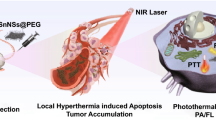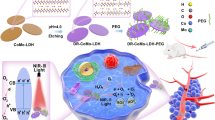Abstract
In this study, we present the preparation of stable 1T-WS2 ultrathin nanosheets with NH +4 intercalation using a bottom-up hydrothermal method and the potential application of this material in light-induced photothermal cancer therapy. Our results revealed that nanosheets with a size of 150 nm were highly hydrophilic and exhibited strong light absorption and excellent photostability in the broad near-infrared wavelength region. The in vitro experimental results indicated good biocompatibility of the nanosheets. More notably, our in vivo antitumor experiments illustrated that light-induced photothermal ablation originating from irradiation of the 1T-WS2 nanosheets with an 808 nm laser could efficiently kill tumor cells; these effects were obtained not only at the cellular level but also in the living organs of mice. This result may lead to new applications of two-dimensional layered materials in novel photothermal therapies and other photothermal related fields.

Similar content being viewed by others
References
Jöbsis-vander Vliet, F. F. Discovery of the near-infrared window into the body and the early development of nearinfrared spectroscopy. J. Biomed. Opt. 1999, 4, 392–396.
Huang, X. H.; El-Sayed, I. H.; Qian, W.; El-Sayed, M. A. Cancer cell imaging and photothermal therapy in the nearinfrared region by using gold nanorods. J. Am. Chem. Soc. 2006, 128, 2115–2120.
Tang, S. H.; Chen, M.; Zheng, N. F. Sub-10-nm Pd nanosheets with renal clearance for efficient near-infrared photothermal cancer therapy. Small 2014, 10, 3139–3144.
Wang, S. T.; Chen, K. J.; Wu, T. H.; Wang, H.; Lin, W. Y.; Ohashi, M.; Chiou, P. Y.; Tseng, H. R. Photothermal effects of supramolecularly assembled gold nanoparticles for the targeted treatment of cancer cells. Angew. Chem., Int. Ed. 2010, 49, 3777–3781.
Wang, J.; Zhu, G. Z.; You, M. X.; Song, E. Q.; Shukoor, M. I.; Zhang, K. J.; Altman, M. B.; Chen, Y.; Zhu, Z.; Huang, C. Z.; Tan, W. H. Assembly of aptamer switch probes and photosensitizer on gold nanorods for targeted photothermal and photodynamic cancer therapy. ACS Nano 2012, 6, 5070–5077.
Ke, H. T.; Wang, J. R.; Dai, Z. F.; Jin, Y. S.; Qu, E. Z.; Xing, Z. W.; Guo, C. X.; Yue, X. L.; Liu, J. B. Gold-nanoshelled microcapsules: A theranostic agent for ultrasound contrast imaging and photothermal therapy. Angew. Chem., Int. Ed. 2011, 50, 3017–3021.
You, J.; Zhang, G. D.; Li, C. Exceptionally high payload of doxorubicin in hollow gold nanospheres for near-infrared light-triggered drug release. ACS Nano 2010, 4, 1033–1041.
Yavuz, M. S.; Cheng, Y. Y.; Chen, J. Y.; Cobley, C. M.; Zhang, Q.; Rycenga, M.; Xie, J. W.; Kim, C.; Song, K. H.; Schwartz, A. G. et al. Gold nanocages covered by smart polymers for controlled release with near-infrared light. Nat. Mater. 2009, 8, 935–939.
Ye, E. Y.; Win, K. Y.; Tan, H. R.; Lin, M.; Teng, C. P.; Mlayah, A.; Han, M. Y. Plasmonic gold nanocrosses with multidirectional excitation and strong photothermal effect. J. Am. Chem. Soc. 2011, 133, 8506–8509.
Yuan, H.; Fales, A. M.; Vo-Dinh, T. TAT peptidefunctionalized gold nanostars: Enhanced intracellular delivery and efficient NIR photothermal therapy using ultralow irradiance. J. Am. Chem. Soc. 2012, 134, 11358–11361.
Terentyuk, G.; Panfilova, E.; Khanadeev, V.; Chumakov, D.; Genina, E.; Bashkatov, A.; Tuchin, V.; Bucharskaya, A.; Maslyakova, G.; Khlebtsov, N. et al. Gold nanorods with a hematoporphyrin-loaded silica shell for dual-modality photodynamic and photothermal treatment of tumors in vivo. Nano Res. 2014, 7, 325–337.
Liu, Y.; Yin, J.-J.; Nie, Z. H. Harnessing the collective properties of nanoparticle ensembles for cancer theranostics. Nano Res. 2014, 7, 1719–1730.
Kim, J. W.; Galanzha, E. I.; Shashkov, E. V.; Moon, H. M.; Zharov, V. P. Golden carbon nanotubes as multimodal photoacoustic and photothermal high-contrast molecular agents. Nat. Nanotechnol. 2009, 4, 688–694.
Wang, X. J.; Wang, C.; Cheng, L.; Lee, S.-T.; Liu, Z. Noble metal coated single-walled carbon nanotubes for applications in surface enhanced Raman scattering imaging and photothermal therapy. J. Am. Chem. Soc. 2012, 134, 7414–7422.
Hu, S.-H.; Chen, Y.-W.; Hung, W.-T.; Chen, I. W.; Chen, S.-Y. Quantum-dot-tagged reduced graphene oxide nanocomposites for bright fluorescence bioimaging and photothermal therapy monitored in situ. Adv. Mater. 2012, 24, 1748–1754.
Yu, J.; Javier, D.; Yaseen, M. A.; Nitin, N.; Richards- Kortum, R.; Anvari, B.; Wong, M. S. Self-assembly synthesis, tumor cell targeting, and photothermal capabilities of antibodycoated indocyanine green nanocapsules. J. Am. Chem. Soc. 2010, 132, 1929–1938.
Yang, J.; Choi, J.; Bang, D.; Kim, E.; Lim, E. K.; Park, H.; Suh, J. S.; Lee, K.; Yoo, K. H.; Kim, E. K. et al. Convertible organic nanoparticles for near-infrared photothermal ablation of cancer cells. Angew. Chem. 2011, 123, 461–464.
Song, X. J.; Chen, Q.; Liu, Z. Recent advances in the development of organic photothermal nano-agents. Nano Res. 2015, 8, 340–354.
Zhou, M.; Zhang, R.; Huang, M.; Lu, W.; Song, S. L.; Melancon, M. P.; Tian, M.; Liang, D.; Li, C. A chelator-free multifunctional [64Cu]CuS nanoparticle platform for simultaneous micro-PET/CT imaging and photothermal ablation therapy. J. Am. Chem. Soc. 2010, 132, 15351–5358.
Hessel, C. M.; Pattani, V. P.; Rasch, M.; Panthani, M. G.; Koo, B.; Tunnell, J. W.; Korgel, B. A. Copper selenide nanocrystals for photothermal therapy. Nano Lett. 2011, 11, 2560–2566.
Lakshmanan, S. B.; Zou, X. J.; Hossu, M.; Ma, L.; Yang, C.; Chen, W. Local field enhanced Au/CuS nanocomposites as efficient photothermal transducer agents for cancer treatment. J. Biomed. Nanotechnol. 2012, 8, 883–890.
Tian, Q. W.; Tang, M. H.; Sun, Y. G.; Zou, R. J.; Chen, Z. G.; Zhu, M. F.; Yang, S. P.; Wang, J. L.; Wang, J. H.; Hu, J. Q. Hydrophilic flower-like CuS superstructures as an efficient 980 nm laser-driven photothermal agent for ablation of cancer cells. Adv. Mater. 2011, 23, 3542–3547.
Tian, Q. W.; Jiang, F. R.; Zou, R. J.; Liu, Q.; Chen, Z. G.; Zhu, M. F.; Yang, S. P.; Wang, J. L.; Wang, J. H.; Hu, J. Q. Hydrophilic Cu9S5 nanocrystals: A photothermal agent with a 25.7% heat conversion efficiency for photothermal ablation of cancer cells in vivo. ACS Nano 2011, 5, 9761–9771.
Chen, Z. G.; Wang, Q.; Wang, H. L.; Zhang, L. S.; Song, G. S.; Song, L. L.; Hu, J. Q.; Wang, H. Z.; Liu, J. S.; Zhu, M. F. et al. Ultrathin PEGylated W18O49 nanowires as a new 980 nm-laser-driven photothermal agent for efficient ablation of cancer cells in vivo. Adv. Mater. 2013, 25, 2095–2100.
Chou, S. S.; Kaehr, B.; Kim, J.; Foley, B. M.; De, M.; Hopkins, P. E.; Huang, J. X.; Brinker, C. J.; Dravid, V. P. Chemically exfoliated MoS2 as near-infrared photothermal agents. Angew. Chem., Int. Ed. 2013, 52, 4160–4164.
Cheng, L.; Liu, J. J.; Gu, X.; Gong, H.; Shi, X. Z.; Liu, T.; Wang, C.; Wang, X. Y.; Liu, G.; Xing, H. Y. et al. PEGylated WS2 nanosheets as a multifunctional theranostic agent for in vivo dual-modal CT/photoacoustic imaging guided photothermal therapy. Adv. Mater. 2014, 26, 1886–1893.
Liu, Q.; Sun, C. Y.; He, Q.; Liu, D. B.; Khalil, A.; Xiang, T. Wu, Z. Y.; Wang, J.; Song, L. Ultrathin carbon layer coated MoO2 nanoparticles for high-performance near-infrared photothermal cancer therapy. Chem. Commun. 2015, 51, 10054–10057.
Ohuchi, F. S.; Jaegermann, W.; Pettenkofer, C.; Parkinson, B. A. Semiconductor to metal transition of WS2 induced by K intercalation in ultrahigh vacuum. Langmuir 1989, 5, 439–442.
Zak, A.; Feldman, Y.; Lyakhovitskaya, V.; Leitus, G.; Popovitz-Biro, R.; Wachtel, E.; Cohen, H.; Reich, S.; Tenne, R. Alkali metal intercalated fullerene-like MS2 (M = W, Mo) nanoparticles and their properties. J. Am. Chem. Soc. 2002, 124, 4747–4758.
Yang, J.; Wang, H. Y.; Yi, W. J.; Gong, Y. H.; Zhou, X.; Zhuo, R. X.; Zhang, X. Z. PEGylated peptide based reductive polycations as efficient nonviral gene vectors. Adv. Healthcare Mater. 2013, 2, 481–489.
Liu, Q.; Li, X. L.; Xiao, Z. R.; Zhou, Y.; Chen, H. P.; Xiang, T.; Xu, J. Q.; Chu, W. S.; Wu, X. J.; Yang, J. L. et al. Stable metallic 1T-WS2 nanoribbons intercalated with ammonia ions: The correlation between structure and electrical/optical properties. Adv. Mater. 2015, 27, 4837–4844.
Voiry, D.; Yamaguchi, H.; Li, J. W.; Silva, R.; Alves, D. C. B.; Fujita, T.; Chen, M. W.; Asefa, T.; Shenoy, V. B.; Eda, G. et al. Enhanced catalytic activity in strained chemically exfoliated WS2 nanosheets for hydrogen evolution. Nat. Mater. 2013, 12, 850–855.
Timko, B. P.; Dvir, T.; Kohane, D. S. Remotely triggerable drug delivery systems. Adv. Mater. 2010, 22, 4925–4943.
Peng, C. L.; Shih, Y. H.; Lee, P. C. Hsieh, T. M. H.; Luo, T. Y.; Shieh, M. J. Multimodal image-guided photothermal therapy mediated by 188Re-labeled micelles containing a cyanine-type photosensitizer. ACS Nano 2011, 5, 5594–5607.
Zhang, J. L.; Jin, W.; Wang, X. Q.; Wang, J. C.; Zhang, X.; Zhang, Q. A novel octreotide modified lipid vesicle improved the anticancer efficacy of doxorubicin in somatostatin receptor 2 positive tumor models. Mol. Pharmaceutics 2010, 7, 1159–1168.
Yang, K.; Xu, H.; Cheng, L.; Sun, C. Y.; Wang, J.; Liu, Z. In vitro and in vivo near-infrared photothermal therapy of cancer using polypyrrole organic nanoparticles. Adv. Mater. 2012, 24, 5586–5592.
Author information
Authors and Affiliations
Corresponding authors
Additional information
These authors contributed equally to this work.
Electronic supplementary material
Rights and permissions
About this article
Cite this article
Liu, Q., Sun, C., He, Q. et al. Stable metallic 1T-WS2 ultrathin nanosheets as a promising agent for near-infrared photothermal ablation cancer therapy. Nano Res. 8, 3982–3991 (2015). https://doi.org/10.1007/s12274-015-0901-0
Received:
Revised:
Accepted:
Published:
Issue Date:
DOI: https://doi.org/10.1007/s12274-015-0901-0




